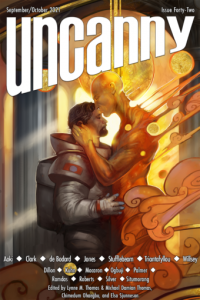Paul Di Filippo reviews James Morrow
Most writers tend to favor either the short story or the novel in their oeuvre, although there are certainly a fair number of play-all-positions types who strike a pretty good balance between the two modes and provide the exceptions to the rule. But generally, literature breaks down into the marathoners versus the sprinters; the big-picture painters versus the vignette sketchers; the strivers for deep, slow effects versus the literary provocateurs with their short sharp shocks.
James Morrow is definitely a novel man. I think it’s fairly safe to say that his sterling reputation rests on his big, complex books like The Last Witchfinder. His bibliographical entry at ISFDB credits him with about thirty short stories in thirty years. Not exactly Ellison or Bradbury levels of production.
So it’s no surprise that his newest offering, The Madonna and the Starship, is also a novel. But what is surprising is its relative brevity, its light-hearted zip, and its rollicking comic tone, compared to the gravitas and black, piercingly satirical humor of his other books. Which is not to say that Morrow’s central theme of the role of religion in humanity’s affairs is absent. Just delivered in a madcap vehicle reminiscent of Kurt Vonnegut and the film Galaxy Quest.
The year is 1953, and our hero/narrator is one Kurt Jastrow, journeyman science fiction writer who is currently earning his daily bread (prozines like Saul Silver’s Andromeda don’t pay very much, even when they do take a story) by scripting the kiddie TV show (filmed live in New York!) that is titled Brock Barton and his Rocket Rangers. Like his tipoff partial namesake, the famed astronomer Robert Jastrow, Kurt is very much a believer in science and the utility of science fiction for conveying lessons and truths about mankind’s place in the universe. He tries to display this fervor in the gee-whiz popular science lesson he conducts on the air at the end of each telecast. And he must be doing a fine job, for he has attracted the attentions of an actual alien race, which has picked up the broadcasts.
The Qualimosans are a race that resembles blue lobsters mated with grasshoppers. Two of them—Volavont and Wulawand—are en route to Earth to present Kurt with an award for his logical positivism, the supremely rationalist creed they honor. All of this is conveyed unexpectedly to Kurt right over the Motorola TV set they have commandeered. Sure enough, the aliens actually arrive, appear live on NBC (taken by the audience to be expertly made-up imposters), and present Kurt with the award. But a hitch ensues: they have also tuned into another show titled Not by Bread Alone, a religious hour scripted by Kurt’s dream girl, Connie Osborne. Abominating superstition, the aliens have vowed to kill every loyal viewer of the sacred show via their own living-room television-sets-turned-death-ray-emitters. Unless, that is, Kurt and Connie can trick the Qualimosans by swiftly rejiggering the broadcast into an acceptably heretical anti-religious lampoon.
Needless to say, Morrow inserts many slapstick complications and farcical events into the rush toward saving two million TV viewers. There’s agoraphobic SF editor Saul Silver playing poker with the aliens. The scripting and rehearsal of the scandalous “The Madonna and the Starship” episode. Kurt and Connie’s tumble into bed—in the studio itself! And many other beautifully enacted wacky bits. Morrow’s story is carried on the backs of many finely sketched bit players—the bohemian crowd Kurt hangs with; the onscreen child actor Andy—and the whole milieu of Eisenhower-era NYC and the early days of TV is made palpable and vivid. I’m reminded of that other classic cinematic exercise in nostalgic hijinks, Richard Benjamin’s My Favorite Year.
And of course this is a meta-SF tale, insofar as it examines the roots and meaning of science fiction and the commercial milieu that supported it, in those far-off days before science fiction became the dominant and commodified entertainment mode it is today. Kurt’s wry observations about the impossibility of making a living from SF, and the unified family-style camaraderie that the genre’s isolated and sparse practioners enjoyed, all summon up a vanished era hard to credit by those living in today’s SF-saturated, fragmented landscape. As we leave Kurt, years after the incident of the Qualimosans, he has just begun to work on a little show called Star Trek, betokening the tectonic shift that would soon occur.
As for the central theme of religion versus rationality, Morrow jabs at both parties. The Qualimosans come off as secular atheist hardnoses like the worst Richard Dawkins stereotype, while the calculated pieties of Not by Bread Alone are no less objectionable. It’s a true Swiftian equality of shame—and of credit where credit is due. The charity-centric fate of the aliens points to Morrow’s real moral: deeds above words.
Like some blend of Rudy Rucker and Howard Waldrop, this latest book by the inimitable James Morrow is rife with gonzo charm and buried barbs and offbeat parables galore.







